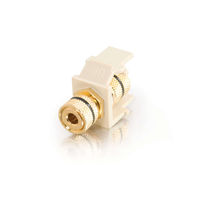I need to move a speaker that's mounted on a wall about 3.5" to the left.

Here's what the actual mounted speaker looks like:

The wire comes out inside the bracket that attaches to the wall, and feeds up into the speaker, so there's no room for wall plates or anything like that.
This is an interior wall, though there is insulation (for soundproofing) in it. I have access to the other side, though it is also finished wall (really I already have to patch this side..). This is in the middle of the stud bay; there is a stud about 5" to the right of the existing wire.
Does anyone have any tricks to doing this in a minimally intrusive way?
UPDATE: Done, Thanks. (Well, aside from another coat of polyfilla, and some touch-up paint). The hole is drilled on almost a 45 degree angle towards the old hole, and I jiggled (technical term) the drill bit around inside so it's larger on the inside, more like a cone.


The tape on the end of the wire has nothing to do with how I pulled it: it's a precaution to avoid shorting out my amp in case it is turned on. Good practice to do anytime you have bare speaker wires that are connected. (Better practice is of course to disconnect the other end, but I digress.)
Thanks all




